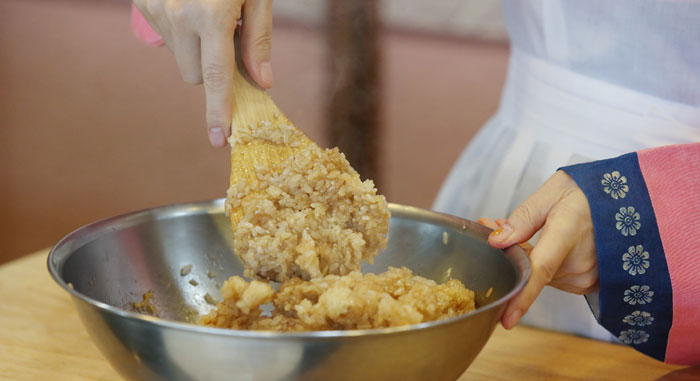
Yaksik cuisine is usually eaten on the Jeongwol Daeboreum, the first full moon of the Lunar New Year. It’s made with healthy ingredients, such as chestnuts, jujubes, pine nuts and honey. Many people make it for Seollal Lunar New Year’s Day and other banquet days. Yaksik takes time and effort to make, as it’s made from natural ingredients and is steamed twice.
The history of yaksik traces back some 1,500 years. The story goes that this style of Korean cuisine represents the communication that took place between humans and animals, as it was originally made for a crow that saved the king’s life.
Yaksik was mentioned in the “Memorabilia of the Three Kingdoms” (Samguk yusa, 삼국유사, 三國遺事), a collection of unofficial histories published by the monk Iryeon (일연, 一然) during Goryeo times (918-1392). When King Soji (d. 500), the 21st king of Silla, went on a picnic on the Jeongwol Daeboreum, he encountered a crow and a mouse. The mouse told the king in human language to follow the crow. The king found this strange and ordered a servant to follow the crow. The crow led him to a pond and then an old man appeared out of the pond. He gave the servant an envelope on which it was written, “Two people will die if you open this. If you don’t open it, only one person will die.”
At first, the king thought it would be better not to open the envelope because that would only cost one person’s life, but he changed his mind when the servant said that the envelope referred to the king himself. When the king opened the envelope, he found a letter that said, “Go back to the palace and shoot an arrow into the box that holds a six-stringed zither,” or a geomungo.
He followed the letter’s instructions and when he shot the arrows into the box, he found two people behind it, bleeding to death. A monk and a concubine were hiding behind the box, ready to kill the king.
The king then set the Jeongwol Daeboreum each year as a day in which people should pay thanks to the crow for saving the king’s life. He ordered the people to create a rite and to cook food for crows made out of rice, chestnuts and jujubes, foods which the bird likes.
Yaksik is made from steamed glutinous rice, jujubes, chestnuts and pine nuts, all of which are mixed with oil, honey and soy sauce. It is also called yakbap or yakban (藥飯). The reason it is called yaksik is because it’s good for the health, almost like medicine, as it’s made from many healthy ingredients. Another reason is because honey is added to it, and people sometimes call honey yak (藥) in Korean.
Historical records that mention yaksik can be found in many Joseon era (1392-1910) books. Heo Gyun (1569-1618), a politician, poet, novelist, scholar and writer, wrote in the “Domundaejak” (도문대작, 屠門大嚼), a book about local delicacies and specialties, that, “The Chinese people love yakban. They learned its recipe and called it ‘Goryeoban.’”
The “Yeoryang Sesigi” (열양세시기, 洌陽歲時記), another Joseon book, written in 1819 by Kim Mae-sun (김매순, 金邁淳) and which concerns annual ceremonies in ancient Seoul, said, “When Korean envoys to China made yaksik and share it with the Chinese people, the nobles in Beijing love it very much.”
How to cook yaksik

Glutinous rice, chestnuts, pine nuts and jujubes are the main ingredients in yaksik.
** Ingredients
270 grams (1.5 cups) of glutinous rice,
1.6 kilograms (8 cups) water in which to steam the rice
salt water: made up of 45 grams (3 tablespoons) water and 2 grams (0.5 teaspoons) salt
20 grams (5) jujubes, 45 grams (3) chestnuts, 3.5 grams (1 teaspoon) pine nuts
jujube stone tea: made up of 5 jujube stones, 200 grams (1 cup) water
sweet steamed rice seasoning: made up of 15 grams (2.5 teaspoons) soy sauce, 32 grams (2 tablespoons) sweet steamed rice sauce, 36 grams (3 tablespoons) brown sugar, 0.5 grams (0.25 teaspoons) cinnamon powder, 6.5 grams (0.5 teaspoons) jujube stone tea, 38 grams (2 tablespoons) honey, 24 grams (2 tablespoons) sugar, 6.5 grams (0.5 tablespoons) sesame oil
sweet steamed rice sauce: made up of 24 grams (2 tablespoons) sugar, 4 grams (1 teaspoon) cooking oil, 2 grams (0.5 tablespoons) starch powder, 45 grams (3 tablespoons) warm water
10 cups of water for steaming the rice
** Preparation
1. Wash the glutinous rice. Soak it in water for about 3 hours. Drain the water through a strainer for 10 minutes to produce about 330 grams of rice.
2. Wipe the jujube with a damp cotton cloth. Cut the flesh off and cut it into 6 pieces, about 16 grams’ worth. Shell the chestnuts and cut them into 6 pieces, about 30 grams each. .
3. Remove the tops of the pine nuts and wipe the nuts dry with a cotton cloth.

Put the white sugar into a small sauce pan over medium heat. As it melts, it becomes brown. Add the oil, starch and water. Boil it together until it’s caramelized. This makes it not too sweet and allows the taste of the individual ingredients to shine through. This technique can be used also in other types of Korean cuisine, such as when making stir-fried japchae noodles, as well as when making yaksik.

Put the glutinous rice into a steaming pot with water and boil it all together. Add some salt and mix it all together. In order to cook tasty steamed rice, the rice should be steamed until it’s fairly tender, neither too hard nor too soft or watery.
** Recipe
1. Pour water into a pot and heat it for 8 minutes over high. When it starts to boil, lay a damp cotton cloth along the bottom of the pan. Put in the glutinous rice and steam it for 20 minutes. Sprinkle in the salt water. Mix it well with a wooden spoon. Steam it for another 30 minutes.
2. Put the jujube stones and water into a pot. Cover it with a lid and let it simmer for 15 minutes over medium. Strain it.
3. Add the sugar to the pot. Heat it for 3 minutes over medium. When the sugar is melted, coat the pan with cooking oil. When the sugar turns to a brownish liquid, add the starch powder and boil it while stirring for 1 minute to make the sweet steamed rice sauce.
4. While the steamed rice is still warm, add the soy sauce, sweet steamed rice sauce, brown sugar, cinnamon powder, jujube stone tea, honey, regular sugar and sesame oil and mix it all together. Add the chestnuts, jujubes and pine nuts and continue to stir.
5. Put the above mixture of steamed glutinous rice into a steaming pot. Steam it for 10 minutes over high. Lower the heat to medium and continue to steam for 20 minutes, while mixing well. Reduce the heat to low and steam it for 20 minutes. Mix it all again and evenly add the seasoning. Finally, steam it for another 10 minutes.
Managed by Yoon Sojung
Photos: Jeon Han
Korea.net Staff Writers
In cooperation with the Institute of Traditional Korean Food (ITKF)
Recipe from “The Beauty of Korean Food: 100 Best-Loved Recipes”
arete@korea.kr

To the steamed rice, add all the ingredients, from the soy sauce through to the white sugar, starting with the darker-colored ingredients. Use both white sugar and brown sugar in order to preserve the fragrance and the taste. Add the chestnuts and pine nuts afterward, otherwise the nuts become soft or crushed. You can also add dried raisins, if you want.

It’s best to steam the glutinous rice in boiling water, as this produces a deeper brown color, a better taste and a sweet smell.























